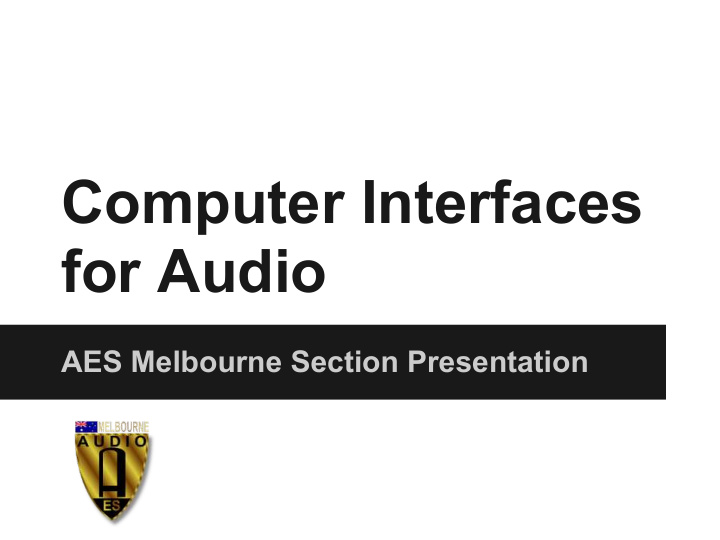



Computer Interfaces for Audio AES Melbourne Section Presentation
define: Language Interface Considerations Driver Clock Support? Stability? Latency? Audio Formats? Sound Quality? Capability? Build Quality? Functionality? Brand? Form-factor? User Supportability? Community?
Audio Processing Device Analog/Digital Out Data Bus Audio Audio Processor Interface Analog/Digital In
Types of A/P Devices ● Proprietary ● Generic - software based, PC hosted ● Hybrid - PC hosted turnkey solutions Focus will be on Generic/Hybrid devices. These both use Generic PC Architectures for information processing.
PC Hardware Architecture RAM GPU CPU RAM DMI N/W SATA PCH USB/FW/TB SOUND PCI/e
PC Hardware Architecture External Ethernet N/W IP- unicast/multicast Streaming USB External PCH Protocol Translator/DSP FW AES/ADAT/SPDIF/MADI Analogue TB Internal Protocol Translator/DSP PCI/e AES/ADAT/MADI/Ethersound Analogue
O/S Architecture Application Executables System Libraries Userspace Libraries/API Operating System/Kernel Process Scheduling Hardware Abstraction Memory Management Device Drivers BIOS I/O, Peripherals
O/S Architecture Application Executables System Libraries/API Userspace Libraries/API 3rd Party API MME CoreAudio ASIO DirectX AudioUnit VST WDM Portaudio RTAS AAX ... Operating System/Kernel
Device Drivers System/3rd Party Libraries/API/SDK etc Hardware Abstraction Device Drivers PCI/e BUS Driver USB BUS Driver FW BUS Driver USB Audio FW Audio PCI/e Audio Device Driver Device Driver Device Driver
Data Interface Capacities USB 2.0 280 Mbit/s Firewire 400 400 Mbit/s Firewire 800 3200 Mbit/s PCI/e 2.0 3200 Mbit/s per "lane" Thunderbolt 6400 Mbit/s
USB interface Interface Examples - FW800 ADAT MIDI RME Fireface 800 FW400 SPDIF AD/DA USB 2.0 ADAT MIDI RME Fireface UFX FW400 AES AD/DA Lynx AES16e PCI/e AES RME MADIFace PCI/e MADI
Interface Characteristics USB 2/3 ● Star/Hub Network Topology ● Published transfer rates are PER CONTROLLER (shared across all devices) ● Host Based (and required) FIREWIRE 400/800 ● Daisy Chain network Topology ● Peer-To-Peer (no host required). PCI/e ● Host Based - Single device.
Protocol Characteristics ● MIDI ○ Serial Data Exchange - Note on/off, Controller ○ Daisy-chained ● ADAT (Lightpipe) ○ Digital Audio - point-to-point ○ Up to 8 channels (@ 48kHz) ● AES3, SPDIF ○ Digital Audio - point-to-point ○ Up to 2 Channels ● MADI (AES10) ○ Digital Audio - Ring Network ○ 64 Channels @ 48kHz
Assumptions for pro work Windows: ● ASIO drivers required MAC: ● CoreAudio drivers required (default)
What is Audio Latency? DELAY
Is this bad? Brain is wired to experience Cause and Effect! With Digital Audio, the "Effect" is always delayed to some extent behind the "Cause". When Recording/monitoring, Cause/Effect need to be aligned as closely as possible and latency minimised. (presonus.com)
What Causes Latency? ● Air (~1ms/ft) ● Peripheral Control Bus Drivers/Hardware ● Audio Device Drivers ● Sound/Audio API/SDK libraries ● Audio Buffers (Tunable) ● Processing Filters
Typical Driver Processing Latencies Windows MME - BAD (>150ms) Windows WDM - BETTER (30ms-150ms) Windows ASIO - BEST (1ms-30ms) AIR 1ms/foot (approx)
CPU/Latency relationship Latency in ASIO drivers can be tuned through use of "buffer sizes". Buffer size determines how many samples are collected before audio processing is performed upon each buffer. The smaller the buffer, the faster the CPU has to work to pump audio data around the system.
CPU/Latency relationship CPU Cycles/second Latency Buffer Size
Round-Trip Latency (presonus.com)
Zero Latency Monitoring Hardware PLL/ADC ENC/DAC DSP/Mixer/ZLM BUFFER BUFFER Data Interface Software BUFFER BUFFER Control Surface Processing / DAW
Deferred Procedure Call (DPC) Latency Windows O/S feature allows high-priority tasks to defer lower priority tasks until they are finished. Allows a system driver to get top I/O priority for critical tasks. In badly written drivers, this can cause large amounts of CPU time to be grabbed, and audio to dropout.
DPC Latency Checker Use DPCLAT.exe to check and correct processor latency issues. Common troublemakers: Network drivers, Wireless drivers, Virus Scanners. Disable drivers and processes until the red goes away.
Main Functionality Blocks DSP AD/DA TRANSLATE SRC INTERFACE
DSP/PCIe CPU Filter DMI PCH DSP PCI/e Filter
DSP/USB CPU Filter DMI Filter PCH DSP USB/FW/TB
Clocks No, Not a Coldplay Track...
A Little bit of Digital Audio Theory....(wikipedia) Analogue audio signal (electrical) In an analog audio signal, the instantaneous voltage of the signal varies continuously with the pressure of the sound waves. Digital Audio Signal A digital signal, in which a continuous quantity is represented by a discrete function which can only take on one of a finite number of values (samples). Digital Audio Sample Digital (numeric) representation of the amplitude of an analogue waveform at a specific point in time.
Digital audio and time Analogue audio is the end goal. Our ears are analogue devices. An Accurate Clock is required to reconstruct the analogue waveform from the digital audio data stream.
Clocks Required to synchronise independent digital sources. 48.0001kHz 47.9999kHz 48.0000kHz Clock Error / Jitter = Increased noise & Total Harmonic Distortion.
Analogue Audio Input CLK Analogue Audio A/D I/F Source
Analogue Audio Output CLK Analogue Audio A/D I/F Sink
Digital Audio Input CLK INPUT/PLL Digital Audio Source I/F (Master Clock Embedded)
Digital Audio Clocks CLK INPUT Clocked Digital Audio Source (Slave Clock) CLK CLK INPUT I/F Clocked Digital Audio Source (Slave Clock) CLK INPUT Clocked Digital Audio Source (Slave Clock)
Digital Audio Input - SRC CLK FREE Running Digital Audio SRC I/F Source
Digital Audio Input External Studio CLK INPUT Master Clock CLK INPUT I/F Clocked Digital Audio Source (Slave Clock)
Digital Audio Input - SRC External Studio CLK INPUT Master Clock I/F Free Running Digital Audio SRC Source
Analogue Audio Input External Studio CLK INPUT Master Clock I/F Analogue Audio A/D Source
Recommend
More recommend